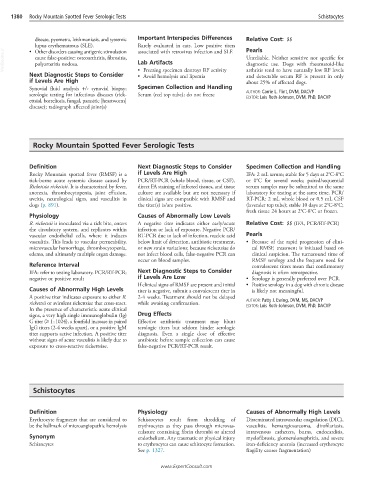Page 2678 - Cote clinical veterinary advisor dogs and cats 4th
P. 2678
1380 Rocky Mountain Spotted Fever Serologic Tests Schistocytes
disease, pyometra, leishmaniasis, and systemic Important Interspecies Differences Relative Cost: $$
lupus erythematosus (SLE). Rarely evaluated in cats. Low positive titers Pearls
VetBooks.ir cause false-positive: osteoarthritis, fibrositis, Lab Artifacts Unreliable. Neither sensitive nor specific for
• Other disorders causing antigenic stimulation
associated with retrovirus infection and SLE
diagnostic use. Dogs with rheumatoid-like
polyarteritis nodosa.
Next Diagnostic Steps to Consider • Freezing specimen destroys RF activity arthritis tend to have naturally low RF levels
• Avoid hemolysis and lipemia
and detectable serum RF is present in only
if Levels Are High about 25% of affected dogs.
Synovial fluid analysis +/- synovial biopsy; Specimen Collection and Handling
serologic testing for infectious diseases (rick- Serum (red top tube); do not freeze AUTHOR: Carrie L. Flint, DVM, DACVP
EDITOR: Lois Roth-Johnson, DVM, PhD, DACVP
ettsial, borreliosis, fungal, parasitic [heartworm]
disease); radiograph affected joint(s)
Rocky Mountain Spotted Fever Serologic Tests
Definition Next Diagnostic Steps to Consider Specimen Collection and Handling
Rocky Mountain spotted fever (RMSF) is a if Levels Are High IFA: 2 mL serum; stable for 5 days at 2°C-8°C
o
tick-borne acute systemic disease caused by PCR/RT-PCR (whole blood, tissue, or CSF), or 0 C for several weeks; paired/sequential
Rickettsia rickettsii. It is characterized by fever, direct FA staining of infected tissues, and tissue serum samples may be submitted to the same
anorexia, thrombocytopenia, joint effusion, culture are available but are not necessary if laboratory for testing at the same time. PCR/
uveitis, neurological signs, and vasculitis in clinical signs are compatible with RMSF and RT-PCR: 2 mL whole blood or 0.5 mL CSF
dogs (p. 891). the titer(s) is/are positive. (lavender top tube); stable 10 days at 2°C-8°C;
fresh tissue 24 hours at 2°C-8°C or frozen.
Physiology Causes of Abnormally Low Levels
R. rickettsii is inoculated via a tick bite, enters A negative titer indicates either early/acute Relative Cost: $$ (IFA, PCR/RT-PCR)
the circulatory system, and replicates within infection or lack of exposure. Negative PCR/
vascular endothelial cells, where it induces RT-PCR due to lack of infection, nucleic acid Pearls
vasculitis. This leads to vascular permeability, below limit of detection, antibiotic treatment, • Because of the rapid progression of clini-
microvascular hemorrhage, thrombocytopenia, or new strain variations; because rickettsiae do cal RMSF, treatment is initiated based on
edema, and ultimately multiple organ damage. not infect blood cells, false-negative PCR can clinical suspicion. The turnaround time of
occur on blood samples. RMSF serology and the frequent need for
Reference Interval convalescent titers mean that confirmatory
IFA: refer to testing laboratory. PCR/RT-PCR: Next Diagnostic Steps to Consider diagnosis is often retrospective.
negative or positive result if Levels Are Low • Serology is generally preferred over PCR.
If clinical signs of RMSF are present and initial • Positive serology in a dog with chronic disease
Causes of Abnormally High Levels titer is negative, submit a convalescent titer in is likely not meaningful.
A positive titer indicates exposure to either R. 2-4 weeks. Treatment should not be delayed
rickettsii or avirulent rickettsiae that cross-react. while awaiting confirmation. AUTHOR: Patty J. Ewing, DVM, MS, DACVP
EDITOR: Lois Roth-Johnson, DVM, PhD, DACVP
In the presence of characteristic acute clinical
signs, a very high single immunoglobulin (Ig) Drug Effects
G titer (≥ 1 : 1024), a fourfold increase in paired Effective antibiotic treatment may blunt
IgG titers (2-4 weeks apart), or a positive IgM serologic titers but seldom hinder serologic
titer supports active infection. A positive titer diagnosis. Even a single dose of effective
without signs of acute vasculitis is likely due to antibiotic before sample collection can cause
exposure to cross-reactive rickettsiae. false-negative PCR/RT-PCR result.
Schistocytes
Definition Physiology Causes of Abnormally High Levels
Erythrocyte fragments that are considered to Schistocytes result from shredding of Disseminated intravascular coagulation (DIC),
be the hallmark of microangiopathic hemolysis erythrocytes as they pass through microvas- vasculitis, hemangiosarcoma, dirofilariasis,
culature containing fibrin thrombi or altered intravenous catheters, burns, endocarditis,
Synonym endothelium. Any traumatic or physical injury myelofibrosis, glomerulonephritis, and severe
Schizocytes to erythrocytes can cause schistocyte formation. iron-deficiency anemia (increased erythrocyte
See p. 1327. fragility causes fragmentation)
www .ExpertConsult.com
www.ExpertConsult.com

